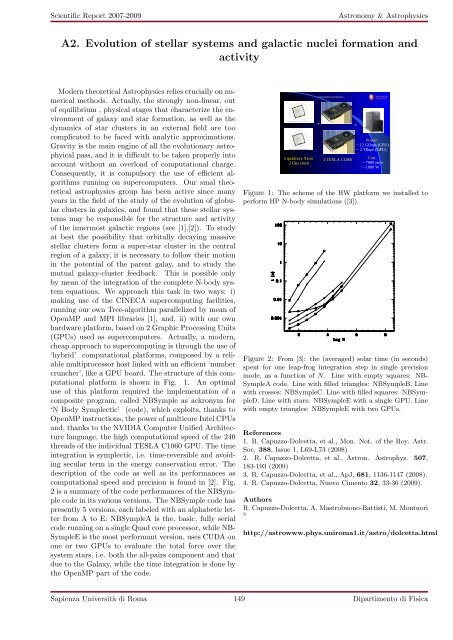download report - Sapienza
download report - Sapienza
download report - Sapienza
Create successful ePaper yourself
Turn your PDF publications into a flip-book with our unique Google optimized e-Paper software.
Scientific Report 2007-2009<br />
Astronomy & Astrophysics<br />
A2. Evolution of stellar systems and galactic nuclei formation and<br />
activity<br />
Modern theoretical Astrophysics relies crucially on numerical<br />
methods. Actually, the strongly non-linear, out<br />
of equilibrium , physical stages that characterize the environment<br />
of galaxy and star formation, as well as the<br />
dynamics of star clusters in an external field are too<br />
complicated to be faced with analytic approximations.<br />
Gravity is the main engine of all the evolutionary astrophyical<br />
pass, and it is difficult to be taken properly into<br />
account without an overload of computational charge.<br />
Consequently, it is compulsory the use of efficient algorithms<br />
running on supercomputers. Our smal theoretical<br />
astrophysics group has been active since many<br />
years in the field of the study of the evolution of globular<br />
clusters in galaxies, and found that these stellar systems<br />
may be responsible for the structure and activity<br />
of the innermost galactic regions (see [1],[2]). To study<br />
at best the possibility that orbitally decaying massive<br />
stellar clusters form a super-star cluster in the central<br />
region of a galaxy, it is necessary to follow their motion<br />
in the potential of the parent galay, and to study the<br />
mutual galaxy-cluster feedback. This is possible only<br />
by mean of the integration of the complete N-body system<br />
equations. We approach this task in two ways: i)<br />
making use of the CINECA supercomputing facilities,<br />
running our own Tree-algorithm parallelized by mean of<br />
OpenMP and MPI libraries [1], and, ii) with our own<br />
hardware platform, based on 2 Graphic Processing Units<br />
(GPUs) used as supercomputers. Actually, a modern,<br />
cheap approach to supercomputing is through the use of<br />
‘hybrid’ computational platforms, composed by a reliable<br />
multiprocessor host linked with an efficient ‘number<br />
cruncher’, like a GPU board. The structure of this computational<br />
platform is shown in Fig. 1. An optimal<br />
use of this platform required the implementation of a<br />
composite program, called NBSymple as ackronym for<br />
‘N Body Symplectic’ (code), which exploits, thanks to<br />
OpenMP instructions, the power of multicore Intel CPUs<br />
and, thanks to the NVIDIA Computer Unified Architecture<br />
language, the high computational speed of the 240<br />
threads of the individual TESLA C1060 GPU. The time<br />
integration is symplectic, i.e. time-reversible and avoiding<br />
secular term in the energy conservation error. The<br />
description of the code as well as its performances as<br />
computational speed and precision is found in [2]. Fig.<br />
2 is a summary of the code performances of the NBSymple<br />
code in its various versions. The NBSymple code has<br />
presently 5 versions, each labeled with an alphabetic letter<br />
from A to E: NBSympleA is the, basic, fully serial<br />
code running on a single Quad core processor, while NB-<br />
SympleE is the most performant version, uses CUDA on<br />
one or two GPUs to evaluate the total force over the<br />
system stars, i.e. both the all-pairs component and that<br />
due to the Galaxy, while the time integration is done by<br />
the OpenMP part of the code.<br />
<br />
<br />
<br />
<br />
<br />
<br />
<br />
<br />
<br />
<br />
<br />
<br />
<br />
<br />
Figure 1: The scheme of the HW platform we installed to<br />
perform HP N-body simulations ([3]).<br />
Figure 2: From [3]: the (averaged) solar time (in seconds)<br />
spent for one leap-frog integration step in single precision<br />
mode, as a function of N. Line with empty squares: NB-<br />
SympleA code. Line with filled triangles: NBSympleB. Line<br />
with crosses: NBSympleC. Line with filled squares: NBSympleD.<br />
Line with stars: NBSympleE with a single GPU. Line<br />
with empty triangles: NBSympleE with two GPUs.<br />
References<br />
1. R. Capuzzo-Dolcetta, et al., Mon. Not. of the Roy. Astr.<br />
Soc. 388, Issue 1, L69-L73 (2008)<br />
2. R. Capuzzo-Dolcetta, et al., Astron. Astrophys. 507,<br />
183-193 (2009)<br />
3. R. Capuzzo-Dolcetta, et al., ApJ, 681, 1136-1147 (2008).<br />
4. R. Capuzzo-Dolcetta, Nuovo Cimento 32, 33-36 (2009).<br />
Authors<br />
R. Capuzzo-Dolcetta, A. Mastrobuono-Battisti, M. Montuori<br />
3<br />
http://astrowww.phys.uniroma1.it/astro/dolcetta.html<br />
<strong>Sapienza</strong> Università di Roma 149 Dipartimento di Fisica

















